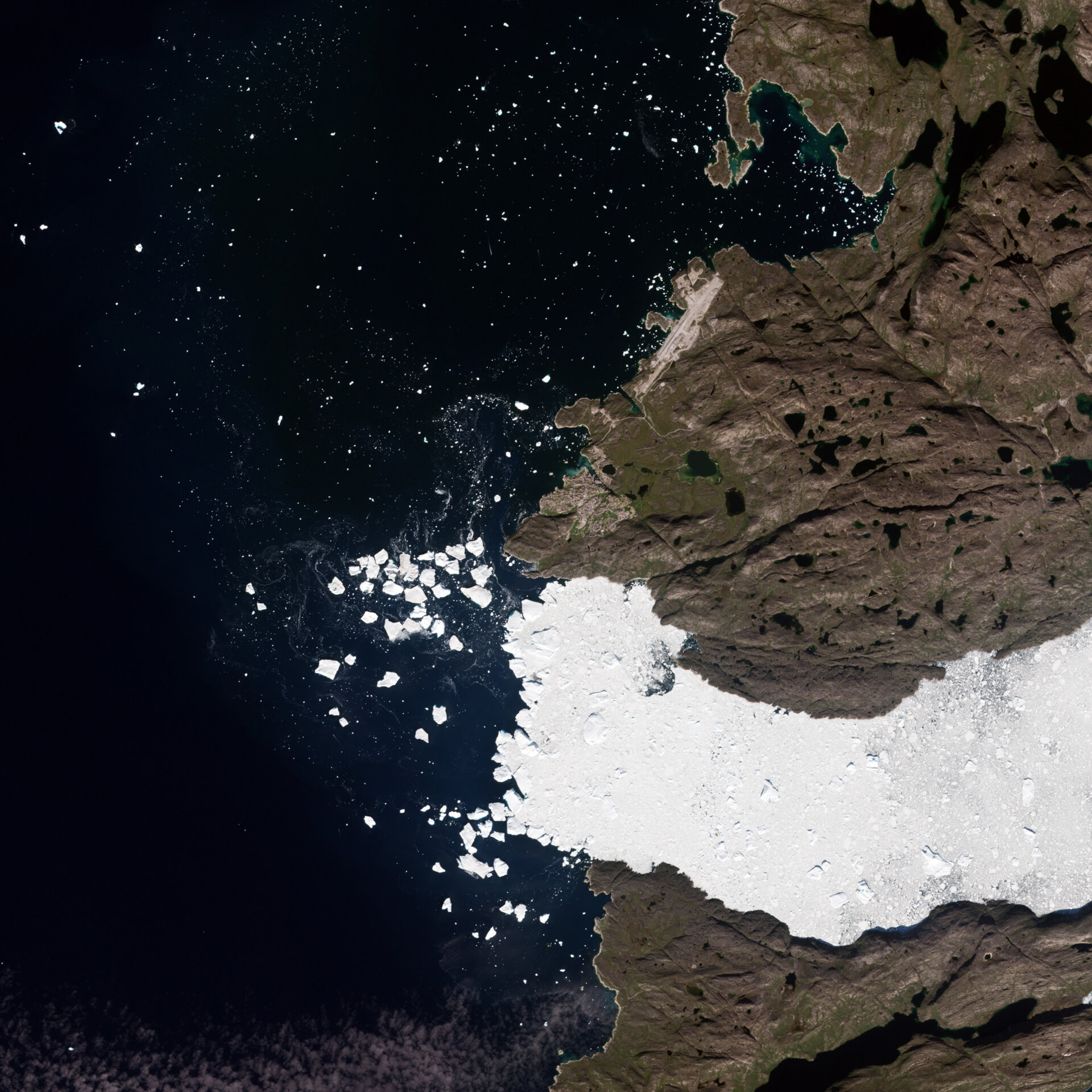Now Reading: Jakobshavn Glacier’s Rapid Retreat Highlights Urgent Climate Change Concerns
-
01
Jakobshavn Glacier’s Rapid Retreat Highlights Urgent Climate Change Concerns
Jakobshavn Glacier’s Rapid Retreat Highlights Urgent Climate Change Concerns


The Jakobshavn Glacier, known as Sermeq Kujalleq in the native Greenlandic language, stands as a colossus of nature, embodying the dynamic interplay between climate and geography. This glacier, one of the fastest and most active in the world, plays a pivotal role in the broader context of the Greenland ice sheet, responsible for draining a significant 6.5% of this vast frozen expanse. Its impact is underscored by the fact that it generates approximately 10% of the icebergs calved from the entire ice sheet, making it a critical component of both local and global climate systems.
The glacier’s sheer scale and majestic beauty are both awe-inspiring and sobering. With towering ice formations that can rise over 100 meters above the water’s surface, Jakobshavn is a showcase of nature’s artistry, with its icebergs resembling sculptures locked in time. These massive structures, some with perimeters reaching up to 2 kilometers, drift through the Ilulissat Icefjord, where they can remain aground for years in shallower waters, melting slowly before eventually breaking apart and dispersing. This process not only affects local ecosystems but also influences sea levels far beyond Greenland’s shores.
What makes Jakobshavn Glacier particularly fascinating is its responsiveness to changing climatic conditions. Studies have shown that it has experienced significant acceleration over the past few decades, a phenomenon that correlates with rising global temperatures. As the glacier retreats and thins, it poses questions that reach into the depths of our understanding of climate change. The retreat of glaciers like Jakobshavn is indicative of a systemic shift in weather patterns, with implications that extend well beyond Greenland.
Visitors to the region, particularly the town of Ilulissat, are afforded a glimpse into this majestic world. The very name ‘Ilulissat’ translates to ‘icebergs,’ highlighting the integral relationship between the town and its icy neighbors. Tourists flock to this vibrant community, drawn by the spectacular sight of icebergs drifting majestically through Disko Bay, often taking boat tours to witness the grandeur up close. Local guides share insights about the glacier’s history and ongoing changes, fostering a deeper appreciation for the delicate balance of the region’s ecosystems.
Recent satellite imagery from the Copernicus Sentinel missions provides an invaluable perspective on Jakobshavn Glacier and its surroundings. The optical images captured by Sentinel-2 reveal the glacier’s calving face, while radar data collected by Sentinel-1 allows scientists to track iceberg movements with unprecedented accuracy. This dual approach enhances our understanding of glacial dynamics and the factors influencing iceberg drift, such as sea depth, ocean currents, and wind patterns, which collectively dictate the fate of these frozen titans.
As we continue to monitor this glacier through advanced satellite technology, it serves as a sentinel of sorts—offering critical data that can help researchers predict future changes and guide local adaptations to climate impacts. The significance of Jakobshavn Glacier extends far beyond its physical presence; it is a symbol of the urgent need for global awareness and action regarding climate change. Each calving event, each shifting iceberg, bears witness to the intricate dance of ice, water, and atmosphere—reminding us of the fragility of the world we inhabit.
The monitoring of iceberg movement from space has revolutionized our understanding of polar regions, particularly in relation to the Jakobshavn Glacier. Using a combination of optical and radar satellite imagery, scientists can effectively track and analyze the dynamics of icebergs as they drift through the fjords of Greenland. The Copernicus Sentinel missions, comprising Sentinel-1 and Sentinel-2 satellites, play an important role in this endeavor, offering distinct yet complementary data that enhance our collective knowledge of ice behavior.
Radar technology, as employed by the Sentinel-1 satellite, operates under a remarkable principle: it can penetrate clouds and capture images irrespective of weather conditions and lighting. This capability is vital in polar environments, where overcast skies and prolonged darkness often obscure optical observations. The radar images generated provide detailed insights into the positioning and size of icebergs, allowing researchers to monitor changes and movements that could be affected by environmental factors such as wind, ocean currents, and tides.
For instance, the capability to capture iceberg positions through radar imaging allows experts to analyze drift patterns over time. Icebergs that are grounded in shallow waters may remain in place for an extended period, but as they melt and lose mass, they are eventually set adrift. This process can be tracked meticulously, revealing not only the movement paths of individual icebergs but also trends that may indicate broader climatic shifts. One fascinating observation is that larger icebergs often drift northward toward Ilulissat, influenced by the prevailing currents of Disko Bay and the Greenland Sea. Researchers have noted that the speed and direction of iceberg movement can vary widely, with some floating relatively slowly while others may navigate swiftly past the fjord’s mouth.
Furthermore, the data generated from these monitoring efforts is invaluable for predicting potential impacts on marine ecosystems and local communities. As icebergs melt, they release freshwater into the ocean, which can alter salinity levels and affect marine life from phytoplankton to large fish species. This ecological interplay showcases the importance of understanding iceberg dynamics not just in isolation but as part of a larger interconnected web of life.
Combining radar data with optical images from Sentinel-2 creates a more holistic view. Optical imagery provides stunning visuals of the glacier’s calving face and the enchanting colors of the icebergs—shades of deep blue and turquoise that indicate varying levels of air trapped within the ice. When analyzed together, these two forms of data allow scientists to correlate iceberg movements with changes in the glacier itself, offering insights into how the glacier is evolving in response to continued warming.
The significance of such monitoring extends beyond scientific curiosity; it has vital implications for local communities and global climate policy. By understanding how icebergs from Jakobshavn Glacier interact with water systems, researchers can inform strategies for climate adaptation and resilience. This knowledge empowers stakeholders in Ilulissat and beyond to prepare for changing conditions, whether that involves fishing practices, tourism management, or infrastructure planning.
As we continue to harness advanced satellite technology for iceberg monitoring, we stand at the frontier of climate science, equipped with new tools to decipher the complex narratives encoded in ice. Each iceberg, each drift analyzed, brings us closer to unraveling the mysteries of our planet’s climatic shifts—serving as a reminder of our responsibility to safeguard the delicate balances within our environment.
Stay Informed With the Latest & Most Important News
Previous Post
Next Post
-
 012024 in Review: Highlights from NASA in Silicon Valley
012024 in Review: Highlights from NASA in Silicon Valley -
 02Panasonic Leica Summilux DG 15mm f/1.7 ASPH review
02Panasonic Leica Summilux DG 15mm f/1.7 ASPH review -
 03From Polymerization-Enabled Folding and Assembly to Chemical Evolution: Key Processes for Emergence of Functional Polymers in the Origin of Life
03From Polymerization-Enabled Folding and Assembly to Chemical Evolution: Key Processes for Emergence of Functional Polymers in the Origin of Life -
 04How New NASA, India Earth Satellite NISAR Will See Earth
04How New NASA, India Earth Satellite NISAR Will See Earth -
 05And Thus Begins A New Year For Life On Earth
05And Thus Begins A New Year For Life On Earth -
 06Astronomy Activation Ambassadors: A New Era
06Astronomy Activation Ambassadors: A New Era -
07SpaceX launch surge helps set new global launch record in 2024




















